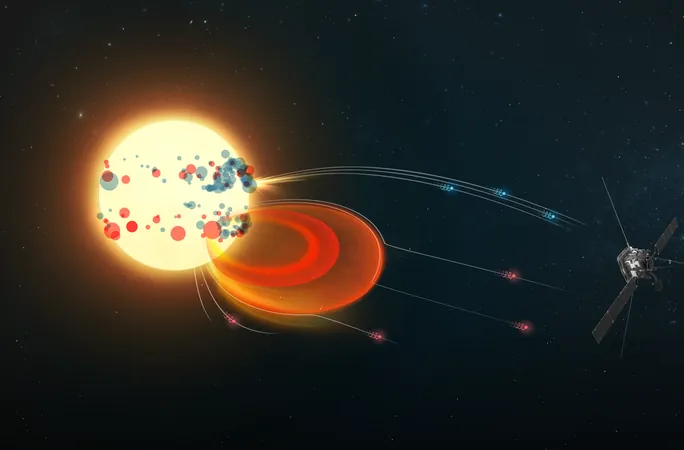
Shocking New Study Reveals Soot's Climate-Altering Power Changes in Hours!
2025-09-03
Author: Rajesh
Billions of Soot Particles: A Hidden Climate Threat
Every second, countless soot particles are unleashed into Earth’s atmosphere—up to 5.8 million metric tons annually! These tiny troublemakers have long been considered significant contributors to climate warming, potentially accounting for nearly one-third of the impact attributed to carbon dioxide.
The Rapid Transformation of Soot
New groundbreaking research from the New Jersey Institute of Technology (NJIT) has uncovered that the climate-altering properties of soot can evolve in mere hours after entering the atmosphere, a stark contrast to the previous assumption that said it took days.
This study sheds light on the phenomenon known as 'atmospheric aging', suggesting that the effects of soot on weather, climate, and air quality may occur far more swiftly than existing atmospheric models can predict.
Surprising Insights from NJIT Researchers
Alexei Khalizov, a chemistry professor at NJIT and the study's senior author, describes soot as an exceptional aerosol: it absorbs sunlight extremely well while barely scattering it, making it a fierce climate influencer right from the start!
He emphasizes the startling speed at which soot alters its composition after release, drastically affecting its capacity to either warm or cool our atmosphere.
The Complex Chemistry Behind Soot Aging
Until now, scientists had limited knowledge about how rapidly soot particles morph in the air. Khalizov explains that nanoparticles quickly gain chemical coatings through capillary condensation—where tiny gaps in their structure attract chemical vapors. As humidity rises, these coatings help soot particles absorb water, transforming both their shape and behavior.
These changes can facilitate cloud formation, enabling the particles to reflect sunlight and contribute to cooling the atmosphere.
Rethinking Soot Models
Previous atmospheric models treated soot as basic spheres, but Khalizov notes that, in reality, soot consists of aggregates—clusters of smaller particles. This complex structure allows soot to gather chemicals at a much faster pace, shifting its warming and cooling effects and its atmospheric longevity.
The Cutting-Edge Research Techniques
At NJIT's Aerosol and Atmospheric Chemistry Lab, researchers employed a tailored aerosol system to investigate the changes in soot particles right after they hit the atmosphere. They focused on particles of approximately 240 nanometers, analyzing their interaction with trace gases under varying humidity conditions.
Advanced instruments captured key changes in real-time, and scanning electron microscopes later revealed the particles’ evolution in astonishing detail.
Simulating Atmospheric Conditions
In a collaboration with NJIT's Laboratory for Materials Interfaces, Khalizov’s team created a novel computer model to simulate how chemical vapors condense on soot. This model highlighted how soot particles acquire liquid-like coatings, enhancing their ability to attract moisture and influence cloud formation—critical aspects of their climate impact.
Soot: A Dual-Effect Climate Agent
The findings indicate that soot particles undergo transformation rapidly, with 80% being processed within hours. In contrast, traditional models treating soot as simple spheres only showed 20% processed—much later!
This swift change makes soot particles more compact and boosts their sunlight absorption, heightening their warming effect. Khalizov points out that fluffy particles evolve into denser blocks, simultaneously enhancing their heat absorption and light reflection, making the overall climate effect of soot far more complex.
Looking Ahead: Understanding Soot's Environmental Impact
The implications of this study could revolutionize our understanding of soot's environmental footprint and lead to more precise climate impact predictions.
Moving forward, the team plans to explore how these rapid transformations affect soot's lifecycle in urban settings and their broader impacts on weather and public health. Khalizov notes, "Understanding this new aging mechanism in polluted urban areas and integrating it within large-scale climate models is crucial for effectively managing soot's environmental footprint."





 Brasil (PT)
Brasil (PT)
 Canada (EN)
Canada (EN)
 Chile (ES)
Chile (ES)
 Česko (CS)
Česko (CS)
 대한민국 (KO)
대한민국 (KO)
 España (ES)
España (ES)
 France (FR)
France (FR)
 Hong Kong (EN)
Hong Kong (EN)
 Italia (IT)
Italia (IT)
 日本 (JA)
日本 (JA)
 Magyarország (HU)
Magyarország (HU)
 Norge (NO)
Norge (NO)
 Polska (PL)
Polska (PL)
 Schweiz (DE)
Schweiz (DE)
 Singapore (EN)
Singapore (EN)
 Sverige (SV)
Sverige (SV)
 Suomi (FI)
Suomi (FI)
 Türkiye (TR)
Türkiye (TR)
 الإمارات العربية المتحدة (AR)
الإمارات العربية المتحدة (AR)